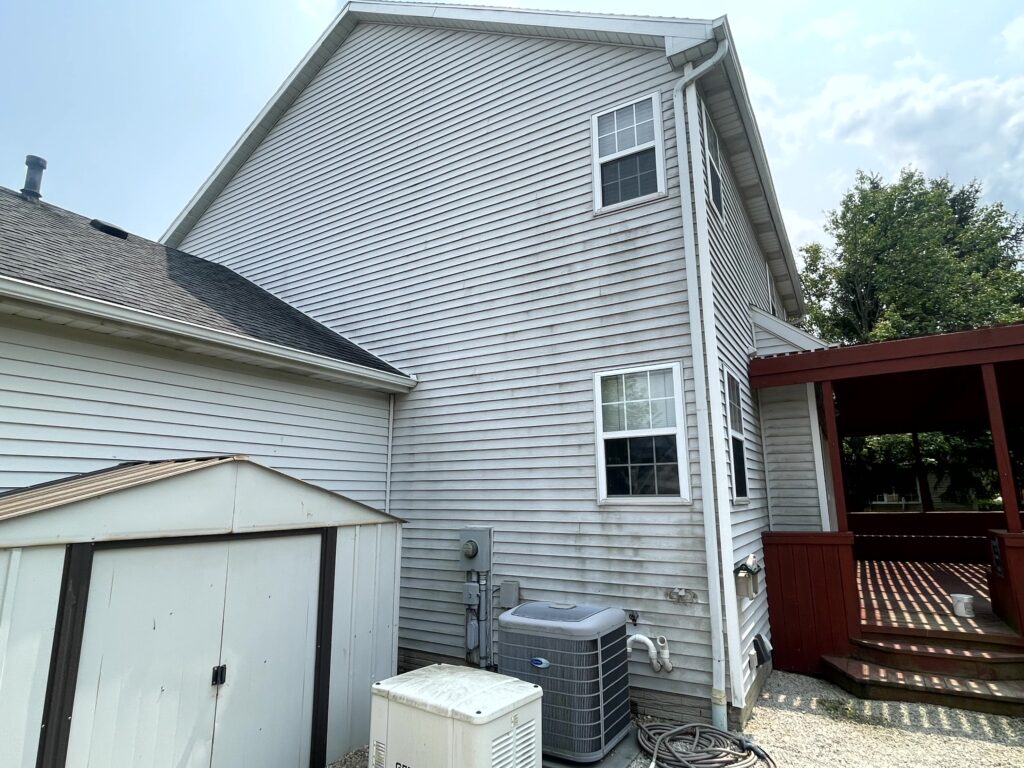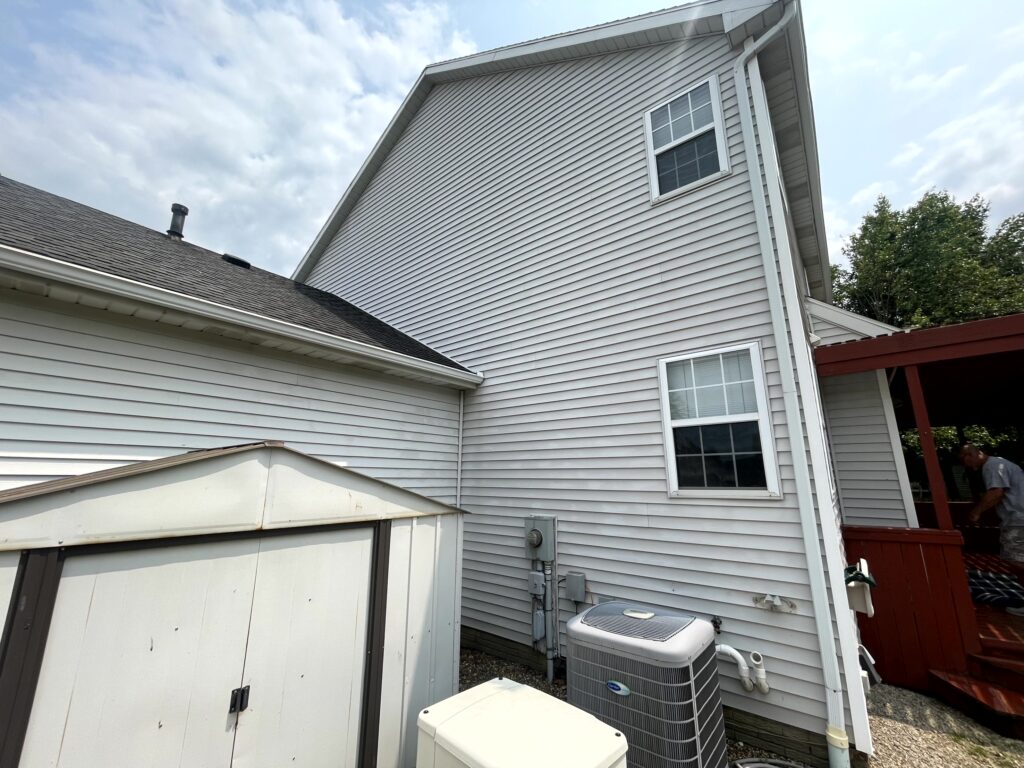The Impact of Pressure Washing on Siding: Understanding Risks and Alternatives


Home maintenance is a critical aspect of homeownership that encompasses a variety of tasks, including the cleaning of exterior siding. Among the most popular methods for house washing are pressure washing and soft washing. These methods are widely used to remove dirt, grime, mold, and algae, ensuring that the siding not only looks appealing but also remains in good condition. However, a common concern among homeowners is whether pressure washing can damage siding and how soft washing serves as a safer alternative. This blog post delves into these concerns, aiming to provide a comprehensive understanding of both cleaning techniques and their impact on different types of siding.
Understanding Pressure Washing
Pressure washing utilizes high-pressure water spray to remove unwanted substances from surfaces such as siding, decks, and driveways. While it’s an effective method for cleaning hard, non-delicate surfaces, it can pose risks to siding materials, especially when not done correctly.
Risks of Pressure Washing Siding:
Damage to Material: High-pressure water can be damaging to certain types of siding, such as vinyl, wood, or aluminum. For instance, too much pressure can lead to dents in aluminum siding, cracks in vinyl siding, or splintering and stripping of paint in wood siding.
Water Penetration: Improper use of a pressure washer can force water behind the siding, leading to moisture buildup. This moisture can cause mold, mildew, and rot, compromising the structural integrity of the home.
Stripping of Protective Coatings: Some siding materials are treated with protective coatings to resist UV damage and weathering. Pressure washing can strip away these coatings, leaving the siding vulnerable to damage.
Tailoring the Approach to Siding Material
Different siding materials have unique vulnerabilities and strengths when it comes to cleaning methods:
Vinyl Siding: Known for its durability and low maintenance, vinyl siding can nevertheless be damaged by high-pressure washing. Soft washing is recommended to avoid warping, cracking, or stripping of the material.
Wood Siding: Wood is particularly susceptible to water damage and can be easily damaged by high pressure. Soft washing not only cleans wood siding gently but also helps in treating and preventing mold and mildew growth without damaging the surface.
Aluminum Siding: While more resistant to water damage, aluminum can dent under high pressure. A careful approach, potentially a low-pressure wash or soft wash, can remove dirt and grime without damaging the siding.
Stucco and Other Textured Surfaces: These materials can harbor dirt and growths within their textures. Soft washing effectively cleans these surfaces without eroding the material or forcing water behind the siding.
DIY vs. Professional Services
For homeowners inclined towards DIY projects, it’s important to weigh the pros and cons of undertaking siding cleaning on their own. While DIY can offer cost savings, it comes with the risk of potential damage if not done correctly. Professional services, on the other hand, might represent an initial investment but come with the assurance of expertise and experience, significantly reducing the risk of damage to your home.
Choosing the Right Method for Your Home
Expanding upon the initial discussion, it’s crucial to delve deeper into how homeowners can navigate the decision-making process when considering the maintenance of their home’s exterior. This extended exploration offers further insights into ensuring the longevity and aesthetic appeal of siding through appropriate cleaning methods.
Importance of Choosing the Right Detergents
When opting for soft washing, the choice of detergent is paramount not only for effective cleaning but also for protecting the siding material and the environment.
Material Compatibility: Ensure that the cleaning solution is suitable for your siding material to prevent adverse reactions, such as discoloration or material degradation.
Environmental Impact: Opt for detergents that are eco-friendly, minimizing harm to your garden, pets, and the local ecosystem. This approach is especially important for homes with rainwater collection systems or those near water bodies.
Regular Maintenance and Inspection
Beyond the choice of cleaning method, regular maintenance and inspection of siding can prevent the buildup of dirt and organic growths that necessitate more aggressive cleaning methods. Seasonal inspections can identify potential issues early, allowing for proactive maintenance that preserves the siding’s condition over time.
Long-Term Siding Care Strategies
Maintaining your home’s siding is not just about the occasional clean. Implementing long-term care strategies can significantly extend the life of your siding, irrespective of its material.
Preventative Measures: Regularly check for and address factors that contribute to siding wear and tear, such as overhanging branches that may scrape the siding or excessive moisture from poorly directed downspouts.
Immediate Repairs: Addressing minor damages or issues immediately can prevent them from escalating into problems that require extensive repairs or even replacement of siding sections.
Aesthetic and Value Implications
The condition of your home’s siding has a direct impact on its curb appeal and, by extension, its market value.
Aesthetic Appeal: Clean and well-maintained siding makes a strong first impression, enhancing the beauty of your home. This is particularly crucial if you’re considering selling your home.
Home Value: Prospective buyers often perceive the condition of the siding as a reflection of the overall maintenance of the home. Regular cleaning and maintenance can thus contribute to a higher valuation.
Innovations in Siding Maintenance
Technological advancements and innovations in home maintenance tools and products offer new opportunities for siding care.
Eco-Friendly Cleaning Technologies: Innovations in cleaning solutions and methods that reduce water usage and chemical runoff are becoming increasingly available, allowing homeowners to maintain their siding in more sustainable ways.
Advanced Protective Coatings: The development of new protective coatings can enhance the durability of siding materials against UV rays, moisture, and microbial growth, reducing the frequency and intensity of cleaning required.
Educating Homeowners
Awareness and education are key to empowering homeowners to make informed decisions about siding maintenance. Access to resources that offer guidance on the specifics of siding care, understanding the environmental implications of maintenance choices, and recognizing the long-term benefits of regular upkeep are invaluable.
In conclusion, maintaining the siding of a home is a multifaceted task that goes beyond the simple choice between pressure washing and soft washing. It encompasses a comprehensive approach that includes understanding the material specifics, implementing long-term care strategies, choosing environmentally friendly cleaning agents, and staying informed about maintenance innovations. By adopting a holistic approach to siding maintenance, homeowners can ensure their property remains aesthetically pleasing, structurally sound, and valuable for many years to come. This commitment to diligent care and maintenance not only preserves the integrity of the home but also contributes to sustainable living practices.
The Soft Washing Alternative
Soft washing is a cleaning method that uses low-pressure water combined with special detergents to clean surfaces gently and effectively. This method is particularly suited for cleaning siding, as it mitigates the risks associated with high-pressure washing.
Benefits of Soft Washing:
Gentle on Siding Materials: Soft washing uses lower water pressure, which is less likely to cause damage to siding materials like vinyl, wood, or stucco. This makes it a safe cleaning method for almost all types of siding.
Effective Removal of Organic Growth: The detergents used in soft washing are designed to kill mold, algae, and other organic substances at their source. This not only cleans the surface but also inhibits future growth.
Preservation of Protective Coatings: Unlike pressure washing, soft washing does not strip protective coatings from the siding. This helps maintain the siding’s durability and resistance to environmental factors.
